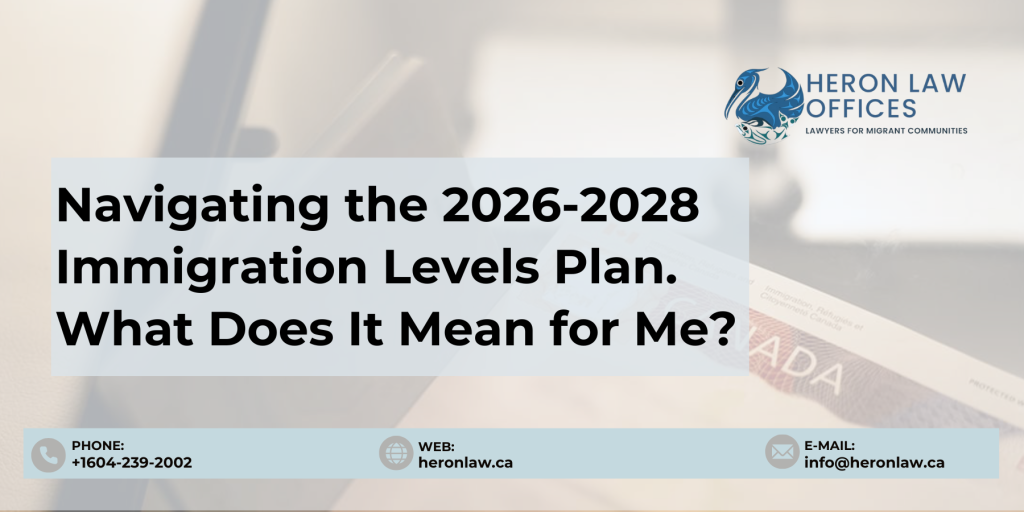
Author: Karina Juma, Canadian Immigration & Refugee Lawyer, Heron Law Offices
On November 5, 2025, the federal government released its Immigration Levels Plan for the next three years (2026 to 2028).
The federal government is reducing Canada’s temporary resident population to less than 5% of the total population by the end of 2027, while prioritizing the transition to permanent residence for skilled and qualified individuals who are already in Canada.
Francophone immigration outside Quebec is increasing. Family reunification will continue to make up 21-22% of overall permanent resident admissions, while support for refugees and protected persons is decreasing from 15% to 13% of overall permanent resident admissions.
If you are thinking about immigrating to Canada or are already here as a temporary resident, you likely have questions about what these numbers and percentages mean for you. Heron Law Offices is pleased to provide an overview of the Immigration Levels Plan and its potential impacts on applicants with different immigration statuses.
I want to come to Canada. What does this mean for me?
The target for new temporary resident arrivals in 2026 is set at 385,000. This means that 385,000 new workers and students will be admitted to Canada next year, split into 230,000 workers (under both the International Mobility Program and the Temporary Foreign Worker Program) and 155,000 students.
Applicants wishing to come to Canada should ensure that their applications are complete at the time of submission, provide detailed explanations where required, and carefully review checklists and online instructions for the latest updates before submitting their applications.
I’m already a temporary resident in Canada. What does this mean for me?
The 385,000 temporary resident target for 2026 does not include study/work permit extensions or in-Canada study/work permit applications.
Applicants applying for study/work permit extensions or new study/work permits from inside Canada should ensure they meet (and continue to meet) the conditions on their initial permits and carefully review program eligibility requirements (e.g., PGWP, LMIA, etc.) before they apply.
I want to apply for permanent residence in Canada. What does this mean for me?
The target for permanent resident admissions in 2026 is set at 380,000. This number includes economic immigration (239,800), family reunification (84,000), refugees and protected persons (49,300), and humanitarian and compassionate (H&C) and other (6,900).
- Of the 239,800 economic permanent resident admissions, 109,000 admissions are under Express Entry (Federal Skilled Worker Program, Federal Skilled Trades Program, and Canadian Experience Class), while 91,500 admissions are under the Provincial Nominee Program.
- Of the 84,000 family permanent resident admissions, 69,000 admissions are for spouses, partners, and children, while 15,000 are for parents and grandparents.
- Of the 49,300 refugees and protected persons admissions, 20,000 spots are for Protected Persons in Canada and dependents abroad, while 29,300 spots are for resettled refugees.
- Of the 6,900 H&C and other permanent resident admissions, only 1,100 spots are reserved for H&C applicants while 5,800 spots fall into the ‘Other’ category.
The federal government is also implementing a one-time initiative allowing 115,000 Protected Persons in Canada who are already on a pathway to permanent residence to acquire permanent residence over the next two years.
Additionally, the federal government is promising to accelerate the transition to permanent residence of up to 33,000 temporary workers in 2026 and 2027, with a focus on those working in in-demand sectors and in rural areas.
- Applicants applying for permanent residence under one of the economic pathways should ensure they meet the program requirements (e.g., requisite work experience, education, language skills, job duties, etc.) and anticipate increased scrutiny from IRCC (the smallest discrepancies matter).
- Applicants applying under family reunification pathways should similarly be prepared for increased scrutiny (e.g., over genuineness and over minimum necessary income) and prolonged separation from their loved ones (for outside Canada applications) due to processing delays.
- Applications for permanent residence for Protected Persons, H&C, and Other are highly case-dependent. We encourage you to seek legal guidance if you have questions about processing times, meeting the criteria for special relief, and government responses to international conflicts, crises, and other situations.
I’ve already applied for permanent residence in Canada and I’m waiting for my application to be processed. What does this mean for me?
The Immigration Levels Plan sets targets for the number of new permanent residents to be admitted each year, not for the number of applications that will be processed each year.
I’m already a permanent resident in Canada. What does this mean for me?
The Immigration Levels Plan does not affect those who have already become permanent residents.
Where can I find out more about the Immigration Levels Plan?
To learn more about the targets for the coming years, visit: www.canada.ca/en/immigration-refugees-citizenship/corporate/mandate/corporate-initiatives/levels.html and www.canada.ca/en/immigration-refugees-citizenship/corporate/mandate/corporate-initiatives/levels/supplementary-immigration-levels-2026-2028.html
If you have questions about how the Immigration Levels Plan (2026-2028) will impact your Canadian immigration journey, contact Heron Law Offices today to speak with one of our qualified lawyers.

About the Authour:
Karina Juma (she/her) articled at Heron Law Offices and was called to the bar in British Columbia in May 2025. During articling, Karina gained experience in a variety of immigration matters, including judicial review, inadmissibility matters, procedural fairness letters, temporary and permanent residence applications, immigration appeals, reconsideration requests, and CBSA enforcement actions.
She completed her Master of Arts in International Affairs at Carleton University, specializing in Health, Displacement, and Humanitarian Policy, and simultaneously earned her Juris Doctor from the University of Ottawa in June 2024, with Magna Cum Laude distinction. She maintained a high level of academic excellence throughout her law studies. Prior to law school, she graduated Summa Cum Laude with a Bachelor of Social Sciences in History and Political Science from the University of Ottawa in 2020.





